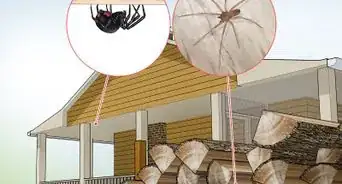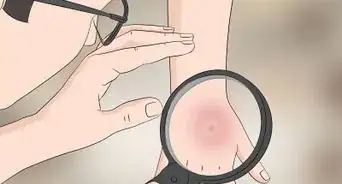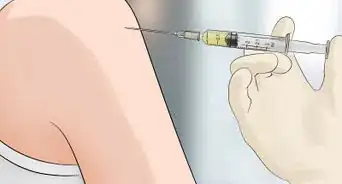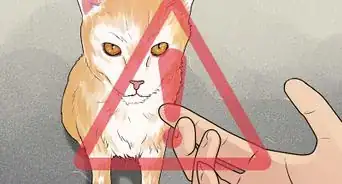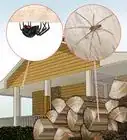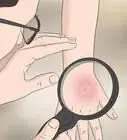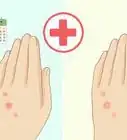This article was co-authored by Samuel Ramsey, PhD. Dr. Samuel Ramsey is an Entomologist and a researcher with the United States Department of Agriculture. Dr. Ramsey has extensive knowledge of symbiosis and specializes in insect disease spread, parasite behavior, mutualism development, biological control, invasive species ecology, pollinator health, and insect pest control. He holds a Bachelor’s degree in Entomology from Cornell University and a Ph.D. in Entomology from the University of Maryland. Dr. Ramsey’s research on bees has enabled researchers to develop targeted control techniques to restore honey bee populations worldwide. He also hosts a YouTube series called “Dr. Buggs.”
There are 7 references cited in this article, which can be found at the bottom of the page.
wikiHow marks an article as reader-approved once it receives enough positive feedback. In this case, several readers have written to tell us that this article was helpful to them, earning it our reader-approved status.
This article has been viewed 279,772 times.
In the United States, most spiders you come across are harmless, but the brown recluse spider is an exception. The brown recluse spider is aptly named because it behaves like a recluse. This nocturnal spider likes to hide in dark places where it will not easily be disturbed, like under porches, in closets, or in wood piles. Its important to identify a brown recluse spider and its venomous bite, which can cause more severe symptoms than other spiders. It’s bite has been to known to be fatal, especially for children.[1]
Steps
Identifying a Recluse Spider Bite
-
1Find the spider that bit you, if possible. If you can, try to trap the spider that bite you to determine if it is a recluse spider. You can also try to remember the appearance of the spider that bite you. A recluse spider is tan all over, with legs attached to the upper part of its body.[2]
- You don't have to catch the spider. Even taking a picture of the spider with your phone can help the medical professionals to identify the spider and treat you.
- This spider gets its nickname, "fiddleback", because of the unique violin-shaped marking on the back of the upper body part. The lower body part doesn't have any markings.
- A recluse spider has three pairs of eyes across the violin-shaped marking, rather than the two rows of four eyes that most U.S. spiders have.
-
2Recognize the symptoms of a brown recluse bite. When you are first bitten, you may not feel anything. Within hours of the bite, you may feel mild burning or irritation in or around the bite wound. You may also have the following symptoms:[3]
- Severe swelling and pain at the bite site.
- A blister may develop that is blue in the center and ringed by redness, like a bull’s eye. The blister may then burst, and the area will enlarge into an ulcer that extends deep into the tissue.
- A pimple-like lesion with yellow or green pus.
- A rash around the bite site that itches.
- Your urine may appear dark in color.
- You may also experience fever, chills, nausea, vomiting, seizures, or joint pain.
- Like other spider bites, a recluse (fiddleback) spider bite will leave a small red mark. Unlike other spider bites, soon after the bite, a small white blister will appear and the tissue around the bite will become hard. The bite will then turn into a lesion that is blue-gray or blue-white, with ragged edges surrounded by redness. If left untreated, the skin around the recluse spider bite can become gangrenous, and develop into a large open wound.[4]
Advertisement -
3Understand where these spiders are often found. Brown recluse spiders like dark, sheltered areas, like under porches, in woodpiles, basements, closets, and under sinks. Consider if you were in any of these areas when you were bitten.[5]
- Though the brown recluse spider can be found all over the United States, it is commonly found in Missouri, Arkansas, Louisiana and Alabama; most of Mississippi, Oklahoma, Nebraska, Tennessee and Kentucky; the southern portions of Iowa, Illinois and Indiana; northern Georgia and eastern Texas.[6]
Treating a Recluse Spider Bite
-
1Try to see a doctor the same day you received the bite. If possible, bring the spider who bite you in to the doctor’s office. Identification of the spider will help your doctor diagnose you properly.[7]
- You can proceed with home care treatment once you are bitten. But you should try to see a doctor or medical professional as soon as possible after you are bitten as the bite could be serious or fatal.
-
2Clean the bite area with soap and rinse with water. Use a clean cloth and dip it in mild soap and room temperature water. Clean the bite area in small circular motions.[8]
-
3Reduce swelling by placing a cool compress over the bite. Wrap ice in a clean towel or put ice in a plastic bag and then wrap it in a clean washcloth or towel.[9]
- Place the compress over the bite for 10 minutes and then take it off for 10 minutes. Repeat this process in 10 minute intervals.
- If the person who is bitten has circulatory problems, reduce the time the compress is on the bite site.
-
4Elevate the bite area. This will slow the spread of the venom from the bite site to the rest of your body and reduce any swelling of the bite area.[10]
- Wrap a compression bandage above the bite to reduce pain and swelling. If you do not have an actual compression bandage, tying any cloth above the bite site can slow down the spread of the venom. Raise the arm, hand, leg or foot with the bite above your heart by propping it up on a pillow. Make sure the bandage is snug, but is not cutting off your circulation.
-
5Do not apply heat to the area. This will only accelerate the tissue destruction around the bite and increase swelling and pain. You should also never attempt to remove the spider venom with a suction device or cut out the affected tissue.[11]
- Avoid applying any steroid creams to the bite area, such as hydrocortisone cream.
-
6Take over-the-counter pain medications. Acetaminophen (Tylenol), ibuprofen or naproxen will help reduce the swelling and pain.[12] .
- You can also take an antihistamine to alleviate any itchiness around the bite area.
-
7Talk to your doctor about medical treatment for the bite. At your doctor’s appointment, or in emergency care, confirm the bite is a recluse spider bite and allow the doctor to treat the bite. After the initial evaluation, your doctor may prescribe the following treatments:[13]
- A Tetanus immunization shot.
- Antibiotics, if there are signs of infection in the wound.
- Antihistamines, such as Benadryl, to help with itchiness.
- Pain medications.
-
8Follow up with the doctor in three to four days. Schedule a follow up appointment with the doctor to confirm you do not have any infections or complications due to the recluse spider bite. It's important to monitor your recovery so the bite does not get worse or become infected.[14]
- If there is damaged tissue around the bite, talk to your doctor about having it surgically removed.[15]
Expert Q&A
-
QuestionIf I have an itchy small pimple like thing on my leg that feels like it burns if I touch it, could it be a brown recluse bite?
 Samuel Ramsey, PhDDr. Samuel Ramsey is an Entomologist and a researcher with the United States Department of Agriculture. Dr. Ramsey has extensive knowledge of symbiosis and specializes in insect disease spread, parasite behavior, mutualism development, biological control, invasive species ecology, pollinator health, and insect pest control. He holds a Bachelor’s degree in Entomology from Cornell University and a Ph.D. in Entomology from the University of Maryland. Dr. Ramsey’s research on bees has enabled researchers to develop targeted control techniques to restore honey bee populations worldwide. He also hosts a YouTube series called “Dr. Buggs.”
Samuel Ramsey, PhDDr. Samuel Ramsey is an Entomologist and a researcher with the United States Department of Agriculture. Dr. Ramsey has extensive knowledge of symbiosis and specializes in insect disease spread, parasite behavior, mutualism development, biological control, invasive species ecology, pollinator health, and insect pest control. He holds a Bachelor’s degree in Entomology from Cornell University and a Ph.D. in Entomology from the University of Maryland. Dr. Ramsey’s research on bees has enabled researchers to develop targeted control techniques to restore honey bee populations worldwide. He also hosts a YouTube series called “Dr. Buggs.”
Entomologist Brown recluse spider bites are often confused with regular skin infections or inflammations. Go to your doctor to get a professional opinion and diagnosis of the bump.
Brown recluse spider bites are often confused with regular skin infections or inflammations. Go to your doctor to get a professional opinion and diagnosis of the bump.
Things You'll Need
- Ice
- Clean washcloth or towel
- Compression bandage
- Pain reliever
- Antihistamine
References
- ↑ http://www.nlm.nih.gov/medlineplus/ency/article/002859.htm
- ↑ http://www.medicinenet.com/black_widow_brown_recluse_pictures_slideshow/article.htm
- ↑ http://www.nlm.nih.gov/medlineplus/ency/article/002859.htm
- ↑ http://www.livescience.com/39996-brown-recluse-spiders.html
- ↑ http://www.medicinenet.com/black_widow_brown_recluse_pictures_slideshow/article.htm
- ↑ http://www.nlm.nih.gov/medlineplus/ency/article/002859.htm
- ↑ http://www.emedicinehealth.com/spider_bite_brown_recluse_spider_bite/page4_em.htm#when_to_seek_medical_care
- ↑ http://www.nlm.nih.gov/medlineplus/ency/article/002859.htm
- ↑ http://www.drugs.com/cg/brown-recluse-spider-bite.html
- ↑ http://www.nlm.nih.gov/medlineplus/ency/article/002859.htm
- ↑ http://www.emedicinehealth.com/spider_bite_brown_recluse_spider_bite/page6_em.htm
- ↑ http://www.emedicinehealth.com/spider_bite_brown_recluse_spider_bite/page6_em.htm
- ↑ http://www.emedicinehealth.com/spider_bite_brown_recluse_spider_bite/page7_em.htm#brown_recluse_spider_bite_treatment
- ↑ http://www.emedicinehealth.com/spider_bite_brown_recluse_spider_bite/page7_em.htm#brown_recluse_spider_bite_treatment
- ↑ http://www.drugs.com/cg/brown-recluse-spider-bite.html
About This Article
If you're bitten by a fiddleback spider, seek medical treatment as soon as possible, since these bites can be fatal, especially to children. Recluse, or fiddleback, spider bites look like small red marks at first that might get itchy and swollen. Soon after, a small white blister will probably appear and the tissue around the bite will go hard. If you spot the spider, it will be tan all over with a violin-shaped marking on its back. If you can't get to a doctor for a few hours, clean the bite area with a mild soap and warm water. Apply an ice pack or bag of frozen vegetables wrapped in a towel to the bite for 10 minutes to help reduce swelling. You can also take an over-the-counter pain medication, like acetaminophen, ibuprofen, or naproxen. For more tips from our Medical co-author, including where fiddleback spiders are usually found, read on.
-Spider-Bites-Step-1-Version-4.webp)
-Spider-Bites-Step-2-Version-3.webp)
-Spider-Bites-Step-3-Version-4.webp)
-Spider-Bites-Step-4-Version-4.webp)
-Spider-Bites-Step-5-Version-4.webp)
-Spider-Bites-Step-6-Version-4.webp)
-Spider-Bites-Step-7-Version-3.webp)
-Spider-Bites-Step-8-Version-3.webp)
-Spider-Bites-Step-9.webp)
-Spider-Bites-Step-10.webp)
-Spider-Bites-Step-11.webp)

